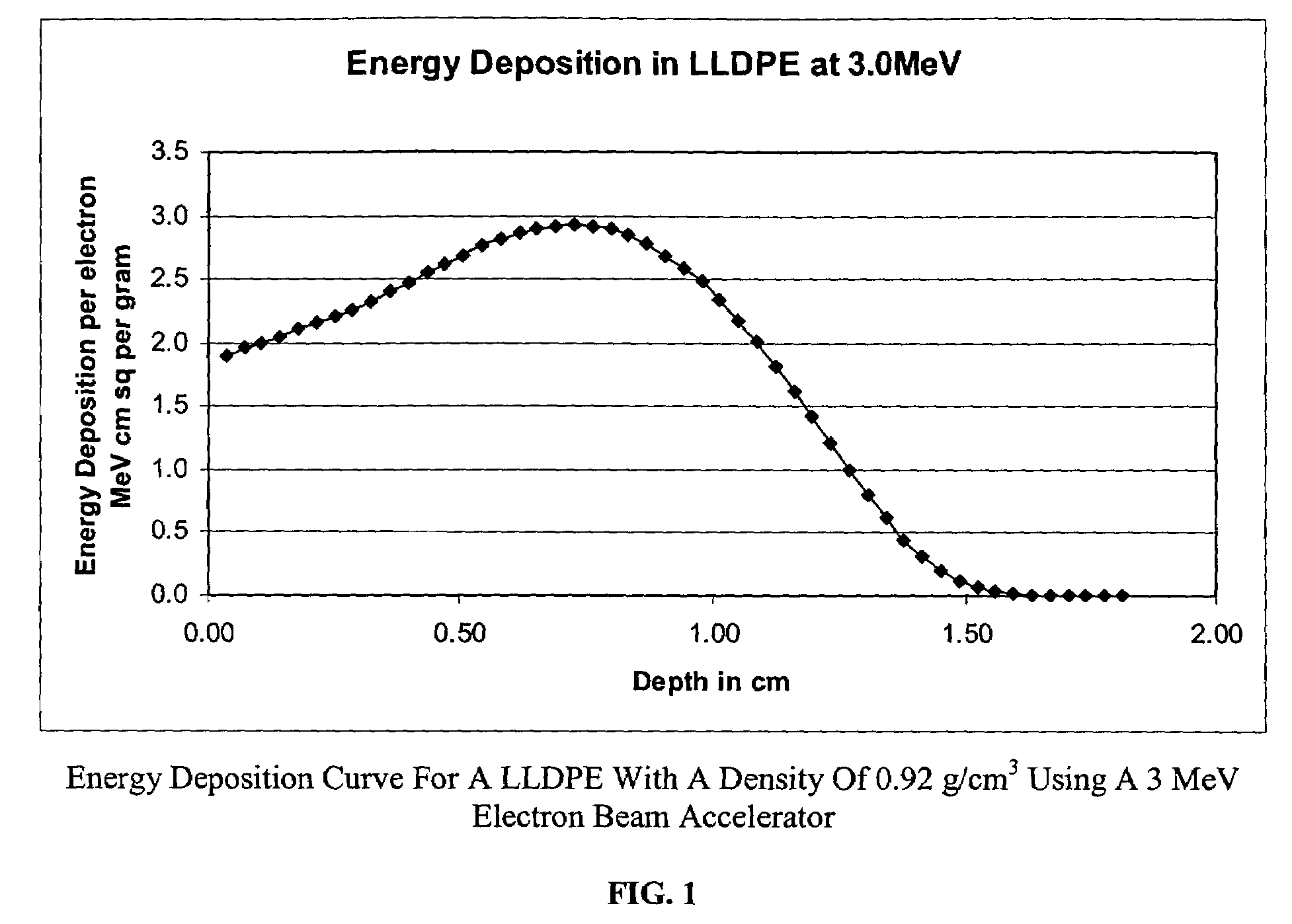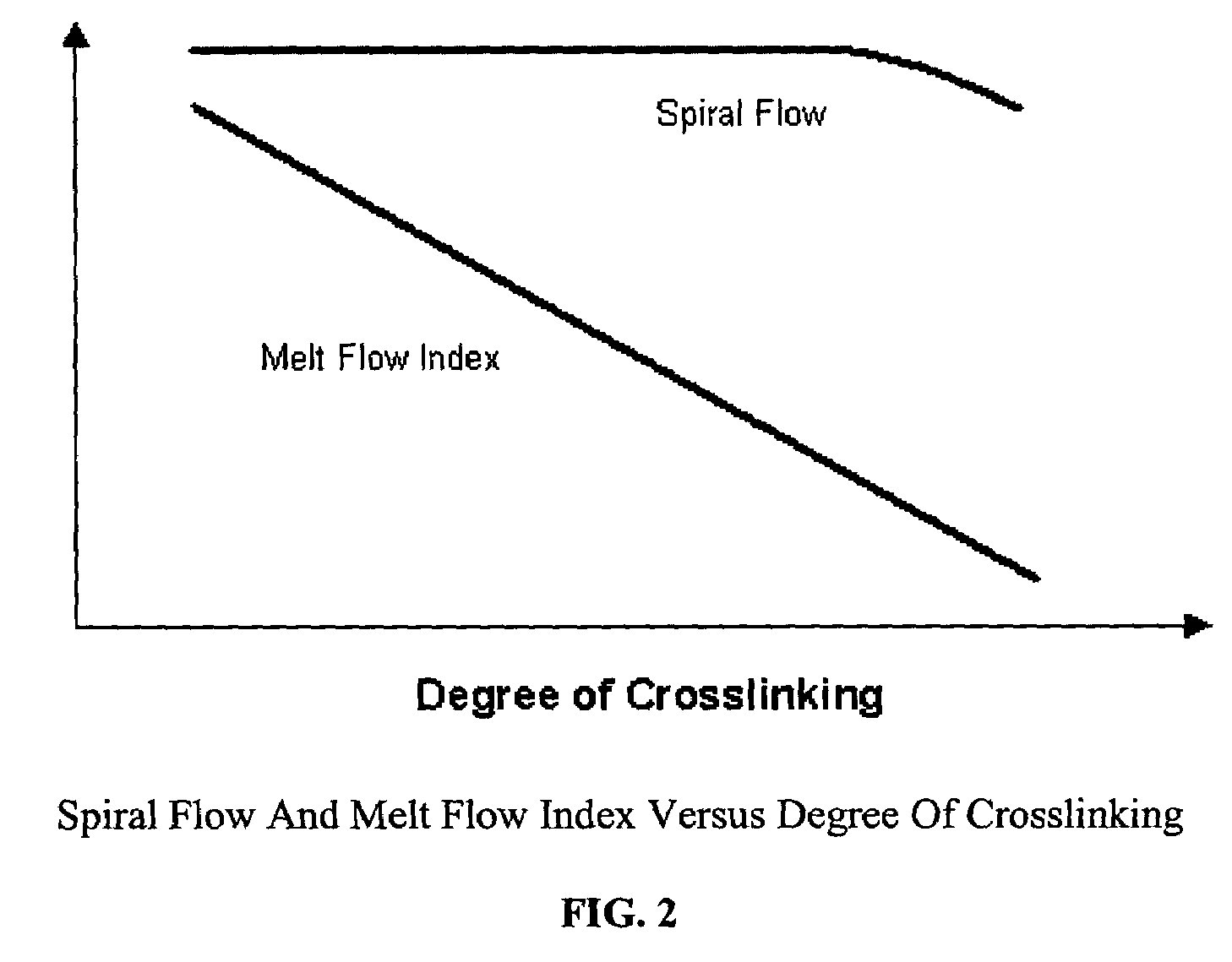Radiation treated ethylene polymers and articles made from said polymers
a technology of ethylene polymer and ethylene polymer, which is applied in the field of irradiation treated ethylene polymers and articles made from said polymers, can solve the problems of poor environmental stress crack resistance (escr, low service temperature), and relatively low mechanical properties of polyethylene, and achieves easy mixing of polar additives, easy adhesion to polar surfaces, and superior compatability and adhesion properties
- Summary
- Abstract
- Description
- Claims
- Application Information
AI Technical Summary
Benefits of technology
Problems solved by technology
Method used
Image
Examples
example 1
6.1 Example 1
Modified Resin For Injection Molding (Electron Beam)
[0114]BP Solvay A60-70-162, an HDPE with a density of 0.963 g / cm3 and a melt flow index of 0.72 g / 10 min (2.16 kg / 190° C.), was used as the non-modified polymer. The polymerization of the resin involves a Cr-based loop slurry catalyst. The resin contains 500 ppm of phenolic antioxidant.
[0115]117 kg of A60-70-162 resin was irradiated with electron beam. The resin was irradiated under ambient atmosphere and temperature in 18 aluminum trays with a dimension of 16″×14″×12″ (depth of each tray is 12″). 6.50 kg of resin were evenly spread in each tray. The electron beam accelerator utilized has an energy of 12 MeV and a beam power of 8 kW.
[0116]The surface dose was targeted at 8 kGy. Dose mapping was carried out using FWT (Far West Technology Inc.) dosimeter films located on the top, at ⅓ of the loading depth, at ⅔ of the loading depth and at the bottom, all located at the center of the tray. The surface dose applied was det...
example 2
6.2 Example 2
Modified Resin For Injection Molding (Gamma Ray)
[0125]Dow's DMDA-8007, an HDPE with a density of 0.963 g / cm3 and a melt flow index of 8.0 g / 10 min (2.16 kg / 190° C.), was used as the non-modified polymer. The polymerization of the resin involves a gas phase catalyst. The resin contains low concentration of antioxidant.
[0126]100 kg of Dow's DMDA-8007 HDPE resin was irradiated with gamma ray. The resin was irradiated under ambient atmosphere and temperature in 20 kg cardboard boxes, each having the dimensions of 16″×12.5″×10″. The 16″×12.5″ side was facing the irradiator so that the depth that gamma ray penetrated was 10″. There was no dead space beyond the space among the pellets. The source activity was 2.2 MCi.
[0127]The minimum irradiation dose was targeted at 16 kGy. Dose mapping was carried out using FWT dosimeter films. A total of 23 dosimeter films were placed on different positions of the five 20 kg cartons and in the middle of the resin. The minimum dose was deter...
example 3
6.3 Example 3
Modified Resin For Injection Molding (Gamma Ray)
[0136]A HDPE (Dow's C7260) was irradiated to a minimum absorbed dose of 16 kGy using gamma irradiation, employing bags containing 25 kg of polymer pellets. In addition, a masterbatch with Irganox B225 additive was made using the irradiated HDPE and this masterbatch was high-speed mixed into the irradiated polymer at a 3% masterbatch load.
[0137]The HDPE composition obtained exhibits a higher notched impact resistance than conventional HDPE, as well as superior stiffness and wear properties. Due to its low melt flow index, the irradiated HDPE composition is more suited to injection molding thicker rather than thinner artifacts. For example, the irradiated HDPE composition is well suited for injection molding luggage handles, clamps, and conveyor parts.
[0138]Various properties exhibited by the irradiated HDPE composition are set forth in Table 6.
[0139]
TABLE 6Properties Exhibited By This Modified HDPEPropertyValueUnitTest Meth...
PUM
| Property | Measurement | Unit |
|---|---|---|
| density | aaaaa | aaaaa |
| degree of crosslinking | aaaaa | aaaaa |
| degree of crosslinking | aaaaa | aaaaa |
Abstract
Description
Claims
Application Information
 Login to View More
Login to View More - R&D
- Intellectual Property
- Life Sciences
- Materials
- Tech Scout
- Unparalleled Data Quality
- Higher Quality Content
- 60% Fewer Hallucinations
Browse by: Latest US Patents, China's latest patents, Technical Efficacy Thesaurus, Application Domain, Technology Topic, Popular Technical Reports.
© 2025 PatSnap. All rights reserved.Legal|Privacy policy|Modern Slavery Act Transparency Statement|Sitemap|About US| Contact US: help@patsnap.com



